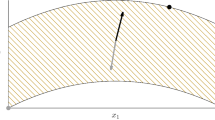Summary
We develop a group-theoretical method to determine the extrema of invariant Higgs potentials of degree four without cubic terms. It applies successfully to the adjoint representations of theO(8+2n) andSU(3+n) groups and to the spinorial representation ofO(14). We give also a method to compute invariants which is very useful for critical orbits.
Riassunto
Mediante la teoria dei gruppi si determina il massimo ed il minimo assoluto di potenziali invarianti di Higgs di quarto grado in assenza di termini cubici. Il metodo è applicato con successo alla rappresentazione regolare dei gruppiO(8+2n) eSU(3+n) e alla spinoriale diO(14). Si presenta anche un metodo di calcolo degli invarianti particolarmente utile per le orbite critiche.
Резюме
Мы развиваем теоретико-групповой метод определения экстремумов инвариантных потенциалов Хиггса четвертой степени без кубических членов. Этот подходи рименяется к сопряженным представлениям грыппO(8+2n) иSN(3+n) и к спинорному представлениюO(14). Мы также предлагаем метод для вычисления инвариантов, которые являются очень полезными для критических орбит.
Similar content being viewed by others
References
H. Georgi andS. L. Glashow:Phys. Rev. Lett.,32, 438 (1974);F. Buccella:The High-Energy Limit, edited byA. Zichichi (Erice, 1980).
L. Michel andL. A. Radicati:Ann. Phys. (N. Y.),66, 758 (1971).
L. Michel: CERN TH 2716 (1979).
H. Ruegg:Phys. Rev. D,22, 2040 (1980).
H. Daniel, G. Lazarides andQ. Shafi:Nucl. Phys. B,170, 156 (1980);C. Dokos andT. Tomaras:Phys. Rev. D,21, 2940 (1980).
L. F. Li:Phys. Rev. D,9, 1723 (1974).
M. Magg andQ. Shafi:Z. Phys. C,4, 63 (1980);F. Buccella, H. Ruegg andC. A. Savoy:Nucl. Phys. B,169, 68 (1980);P. Mitra: Tata Report No. 80-0288 (1980);K. Enquist andJ. Maalampi: HU-TFT-80-10 (1980).
F. Buccella, H. Ruegg andC. A. Savoy:Phys. Lett. B,94, 491 (1980).
H. Fritzsch andP. Minkowski:Ann. Phys. (N. Y.),93, 193 (1974);H. Georgi:Particles and Fields, edited byC. E. Carlson (New York, N. Y., 1975), p. 575;M. Chanowitz, J. Ellis andM. K. Gaillard:Nucl. Phys. B,128, 506 (1977).
M. Gell-Mann, P. Ramond andR. Slansky:Rev. Mod. Phys.,50, 721 (1978);R. Slansky: LA-UR-80-3495 (1980), to be published inPhys. Rep.
R. Brauer andH. Weyl:Am. J. Math.,57, 425 (1935).
M. Günaydin andF. Gürsey:J. Math. Phys. (N. Y.),14, 1651 (1973).
Author information
Authors and Affiliations
Additional information
Work partially supported by the Swiss National Science Foundation.
Переведено редакцией.
Rights and permissions
About this article
Cite this article
Buccella, F., Ruegg, H. Group-theoretical determination of minima of Higgs potentials. Nuov Cim A 67, 61–69 (1982). https://doi.org/10.1007/BF02902431
Received:
Published:
Issue Date:
DOI: https://doi.org/10.1007/BF02902431



